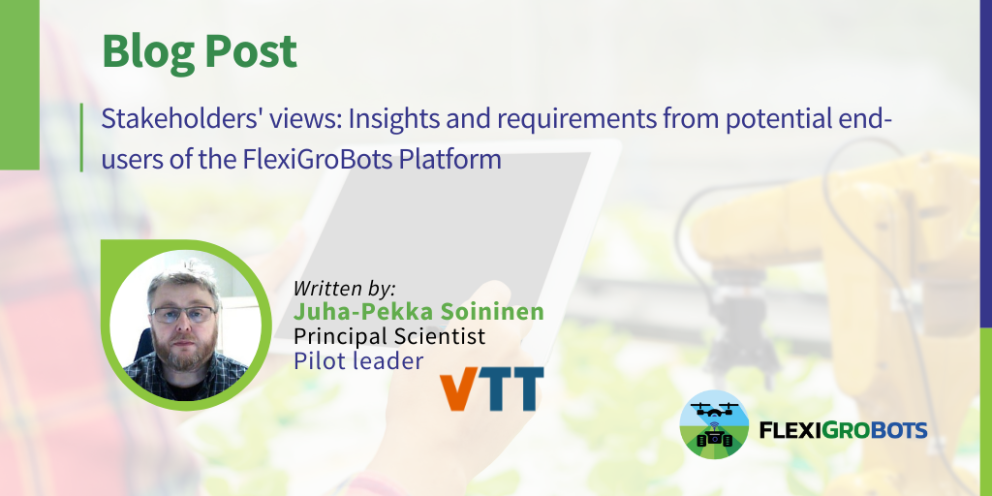Agriculture and farming have been the bases of human civilisation since the idea of being a hunter-gatherer was abandoned more than 10 000 years ago. Throughout these years, agriculture has been adopting new technologies and practices for making it more productive, thus paving the way to feed a larger population, allowing people to focus on other activities than finding food for creating more complex and advanced cultures.
Today we are in the same situation as before, and the root causes to produce more or to produce more efficiently have changed. The number of people globally is constantly increasing and stopping the growth is practically impossible. Water scarcity, climate change, CO2 awareness, and market pull for cleaner and more ecological food products introduce new challenges and opportunities.
Simultaneously the technology development creates new possibilities and applications that could be leveraged in agriculture too. Robotics and automation, the Internet of Things and data, and Artificial Intelligence (AI) are bringing huge possibilities and benefits on how various processes that we have at fields and farms could be done or improved.
These possibilities do not come without costs. New technology is typically expensive. Can we find a sweet spot where benefits exceed the investments? Are we ready to give control to machines and computers? And to what extent? Transforming all the data to digital format has been already proven to be a potential threat to privacy. Are we ready to take such risks? Finally, automation changes the distribution of work, which can lead to the need of converting old skills into new skills. This scenario can bring societal consequences as it boosts the transformation of society, from our traditional culture and processes, into something new and unknown.
FlexiGroBots is part of this process. It aims to take robotics and AI to a new level and to make them usable in the agriculture context. For making the right choices it is essential to make solutions that do their job and are attractive to farmers because they meet their needs and expectations. It is also very important to recognise the threats and fears, to create solutions that avoid them.
As a part of this process, we decided to analyse the views and opinions of our stakeholders and end-users and to use this data for guiding our specification and design efforts.
The objective of our survey was to ask both project partners and external stakeholders about their opinions, views, and expectations about FlexiGroBots key ideas of flexible AI-driven agriculture robot fleets, advanced satellite image services, and the sharing of confidential data. All these ideas are being implemented in the FlexiGroBots platform as an AI development and service platform, geospatial services, multi-robot control centre and agriculture data space.
The survey was implemented as a two-stage Google Forms questionnaire that was first distributed to project partners and then to external replicants that were collected from partners' contacts. The aim was to make a replicant set that consisted mainly of farmers, solution developers, and researchers. The target group was meant to represent people that could be characterised as the first users of new technology. The choice was motivated by the fact that an extensive, full-scale survey would have required a lot more resources, more advanced planning and analysis capabilities, and at least European level distribution. The survey was conducted during the late summer and autumn of 2021. We received 63 answers to the 72 questions from four main categories of replicants:
- Farmers or farming experts
- Farming advisory organisations
- Researchers
- AI solution providers
The detailed results are published in FlexiGroBots project deliverable D2.1 - Stakeholder view to FlexiGroBots system scenarios*, which is available on this website. The main findings of the analysis are that robots and AI are seen as a natural evolution in the domain of agriculture. At least by the first user type of farmers. Farmers are already familiar with using digital tools and robots, and AI services are seen as such.
The concerns related to losing control did not receive much evidence. Data spaces and data sharing are seen as tools for achieving higher in-depth situational awareness of the farm. There is a clear need to keep control of the data, but when multiple benefits of sharing the data come in place, it is considered possible.
AI services, augmented maps, and advanced analytics services are all seen as important. Precision farming and transparency of food production are perceived as the future of agriculture and food production at least in Europe, where society gives firm guidelines and where consumers are increasingly aware and interested in quality and sustainability issues.
We are now in the process of taking these findings and guidelines into account when FlexiGroBots solutions and pilots are taken forward. The results partly confirmed our preliminary views, but they also brought new insights to our design and development process of the FlexiGroBots Platform. The end-users have information that cannot be seen from the ivory towers of research and technology. A successful project needs this information to be heard, considered and applied.
________
*Pending to be approved by the European Commission
